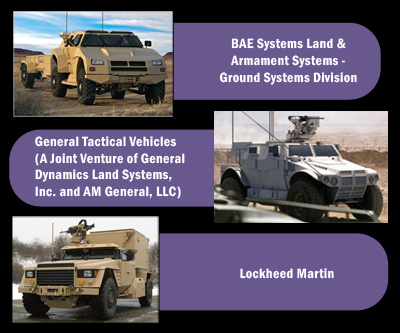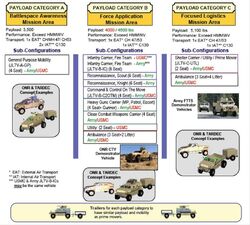| Joint Light Tactical Vehicle | |
|---|---|
 JLTV competitors and their prototypes, some used during the Technology Development phase. | |
| Type | 4-wheeled armored fighting vehicles |
| Place of origin | |
| Production history | |
| Designer | U.S. Army |
| Variants | A:, B:, C:, |
| Specifications | |
| Secondary armament |
up to four M7 smoke grenade dischargers |
| Operational range |
300 miles |
| Speed | Forward Road: 70 mph Off road: varies Reverse: 8 mph |
The Joint Light Tactical Vehicle (JLTV) is a U.S. Army, USSOCOM, and U.S. Marine Corps program to replace the current HMMWV[1] with a family of more survivable vehicles and greater payload. In particular, the HMMWV was not designed to be an armored combat and scout vehicle but has been employed as one, whereas the JLTV will be designed from the ground up for this role.
The JLTV program is related to, but not the same as, the Future Tactical Truck Systems (FTTS) program. Lessons learned from the FTTS have been fed into the JLTV requirements. The future family of vehicles will comprise five armored versions, ranging from infantry combat vehicles, command vehicles, reconnaissance vehicles, and armored utility vehicles.
There will probably also be an armored personnel carrier and a number of other non-armored versions for other purposes such as ambulances, utility vehicles and general purpose mobility. Such a design could also be used in place of an armored personnel carrier or unarmored trucks. However, the JLTV program could be outpaced by the rapid development of lightweight MRAPs.[2]
It appeared the United States Army had reduced their support for JLTV, since some held that the program was omitted from a recent tactical vehicle strategy.[3] However, the Army clarified that it is indeed included as a replacement and complement to Humvees. [4]
History[]
The following companies and partnerships bid for the JLTV contract:
- Boeing, Textron and Millenworks[5][6]
- General Dynamics and AM General (as 'General Tactical Vehicles')[7]
- Force Protection Inc and DRS Technologies[8][9] (officially rejected on August 14, 2008).[10]
- BAE Systems and Navistar[11]
- Northrop Grumman, Oshkosh Truck and Plasan[11][12]
- Lockheed Martin, BAE Systems Land & Armaments Global Tactical Systems, Alcoa Defense and JWF Industries.[13][14]
- Blackwater and Raytheon[15]
On 29 October 2008 the Pentagon narrowed the field of vendors to the Lockheed Martin, General Tactical Vehicles and BAE Systems/Navistar teams to compete for the final version and contract for the JLTV. Each team received contracts worth between $35.9 million and $45 million to begin the second phase of the program, which could ultimately be worth $20 billion or more.[16] The contracts were put on hold following protests by the losing teams, Northrop Grumman-Oshkosh and Textron-Boeing-SAIC. On 17 February 2009, the Government Accounting Office denied the protests.[17]
Australia signed an agreement in February 2009 to fund nine of the first 30 JLTV prototypes.[18] India has become interested in the program in 2009.[19]
As part of a cost-cutting measure, the National Commission on Fiscal Responsibility and Reform suggests canceling the JLTV.[20]
Categories[]

JLTV configurations
There are three primary variants of the JLTV, which are categorized by their payload and general mission, and within that category, further variations may exist for specific purposes. All vehicles share some capabilities, while certain configurations may have additional capabilities. All variants are transportable externally by CH-47 and CH-53 helicopters and internally by C-130 aircraft.[21]
Payload Category A[]
Payload Category A vehicles will fill the role of "Battlespace Awareness" with a payload capacity of 3,500 lb (1,600 kg).[21]
General Purpose Mobility: General Purpose Mobility (JLTV-A-GP) is the only variant in Payload Category A, designed for general purpose utility vehicle for use by the Army and Marine Corps, with a 4 person capacity.[21] Unlike other variants a C-130 is capable of transporting two vehicles at a time.[21]
Payload Category B[]
Payload Category B vehicles will fill the role of "Force Application" with a payload capacity of 4,000–4,500 lb (1,800–2,000 kg).[21]
Infantry Carrier: The Infantry Carrier (JLTV-B-IC) has a 6 person capacity, and is designed to carry a fire-team of Army soldiers or Marines. Each service may get a different vehicle, or they may use the same one.[21]
Reconnaissance, scout: Six seat configuration for use by the US Army.[21]
Reconnaissance, knight: Six seat configuration for use by the US Army.[21]
Command and Control on the Move: Four seat command and control (JLTV-B-C2OTM) configuration for use by the US Army.[21]
Heavy Guns Carrier: Heavy Guns Carrier for use by the US Army and Marine Corps for convoy escort, military police, and patrol with four seats and a gunner position.[21]
Close combat weapons carrier: Four seat close combat weapons carrier for use by the US Army and Marine Corps.[21]
Utility vehicle: Two seat utility vehicle for use by the USMC.[21]
Ambulance: Ambulance configuration for use by the US Army and Marine Corps. 3 seats and 2 litters.[21]
Payload Category C[]
Payload Category C vehicles will fill the role of "Focused Logistics" with a payload of 5,100 lb (2,300 kg).[21]
Shelter carrier/utility/prime mover: Two seat shelter carrier/utility/prime mover for use by the US Army and Marine Corps.[21]
Ambulance: Higher capacity ambulance configuration for use by the US Army and Marine Corps. 3 seats and 4 litters.[21]
Design requirements[]
| This section's factual accuracy may be compromised because of out-of-date information. Please help improve the article by updating it. There may be additional information on the talk page. (March 2010) |
In 2006, Joint Light Tactical Vehicle design requirements included the following.
The JLTV will have two armor kits: the A-kit and a B-kit (which adds additional protection to the A-kit).[22][23] It will also include an extra spall liner to minimize the perforation effects within a vehicle when the vehicle takes hostile fire.[22][24]
The vehicle will be capable of traveling one terrain feature after having endured a single small caliber arms sized perforation to the fuel tank, engine oil reservoir, or coolant system.[22] It will be able to run on two flat tires.[22][24]
The USMC requires a vehicle that can be transported by their current and planned systems. In April 2009, Marine Corps Commandant Gen. James Conway warned that the Marines “will not buy a vehicle that’s 20,000 lb.”[25]
The vehicle's jam-resistant doors will allow the passengers to easily escape after the vehicle has taken damage.[22][24] It will include an automatic fire extinguishing system,[24]
The JLTV will be equipped with a diagnostic monitoring system that will electronically alert the operator of equipment failures so that they can be fixed. The electronic monitoring will observe the fuel, air intake, engine, cooling, transmission, energy storage, power generation and vehicle speed as well as other systems.[22][24]
The JLTV will have a trailer capable of carrying the same payload as its prime mover over the same speeds and mission profile.[22] It will have the capacity to carry various kinds of ammunition.[22]
Mobility[]
Logistical mobility[]
JLTV is transportable by sea, rail, and air. The JLTV will be transportable on all classes of ocean-going transport ships with minimal disassembly. It is required to be rail-transportable on CONUS and NATO country railways. Air transportability will be by fixed-wing aircraft as large as or larger than the C-130 Hercules and sling-loadable with rotary-wing aircraft such as the CH-47/MH-47, and CH-53. The ambulance variant must be air-dropable by C-5 and C-17 fixed-wing aircraft.[26]
Firepower[]
Countermeasures[]
The JLTV utilizes signature reduction techniques and materials. The JLTV mounts up to four M7 Light Vehicle Obscuration Smoke System. The JLTV is designed with a base structure called an A-structure and B-kit armor that provides higher protection levels. JLTV also incorporate various additional survivability technologies to meet overall requirements.The JLTV is designed to accept transparent window armor. To prevent casualties due to fires in combat the fuel tanks are mounted outside the crew compartment and are required to be "self-sealing". Fires in the engine compartment are to be detected and extinguished within 10 seconds to minimize vehicle damage. In addition, the driver also has access to a small portable fire extinguisher.[26]
See also[]
References[]
| This page uses some content from Wikipedia. The original article was at Joint Light Tactical Vehicle. The list of authors can be seen in the page history. As with Tractor & Construction Plant Wiki, the text of Wikipedia is available under the Creative Commons by Attribution License and/or GNU Free Documentation License. Please check page history for when the original article was copied to Wikia |
- ↑ JLTV HMMWV replacement details and specifications
- ↑ Pentagon push for vehicle program menaces another
- ↑ JLTV Sinking, EFV Wobbly
- ↑ [1]
- ↑ Defense Markets Summary October 2007 - from www.Defense-Update.com
- ↑ Defense Tech: A Little LUV for the Future Military Jeep
- ↑ AM General and General Dynamics Announce Joint Venture Company
- ↑ TheStreet.com : Weak MRAP Order Wrecks Force Protection | Aerospace/Defense | CRDN FRPT NAVZ OSK
- ↑ DRS Technologies, Force Protection team to compete for JLTV programme
- ↑ http://www.secinfo.com/dVut2.t9Qq.htm
- ↑ 11.0 11.1 Template error: argument title is required.[dead link]
- ↑ Template error: argument title is required.[dead link]
- ↑ Lockheed Martin And Armor Holdings Announce Teaming Agreement For Joint Light Tactical Vehicles. globalsecurity.org
- ↑ [2]
- ↑ Blackwater, Raytheon Pitch JLTV Candidate
- ↑ http://news.moneycentral.msn.com/provider/providerarticle.aspx?feed=AP&date=20081029&id=9324412
- ↑ Kris Osborne (2009-02-17). "GAO denies protest of Army JLTV award", Army Times Publishing Co..
- ↑ CRS RS22942 Joint Light Tactical Vehicle (JLTV): Background and Issues for Congress
- ↑ McLeary, Paul. "Officials Report Progress With JLTV". Aviation Week, 7 October 2009.
- ↑ "$200 BILLION IN ILLUSTRATIVE SAVINGS" (10). Retrieved on 11 November 2010.
- ↑ 21.00 21.01 21.02 21.03 21.04 21.05 21.06 21.07 21.08 21.09 21.10 21.11 21.12 21.13 21.14 21.15 TACOM-Warren Electronic Contracting
- ↑ 22.0 22.1 22.2 22.3 22.4 22.5 22.6 22.7 Osborn, Kris (July 9, 2007). "Beefing up the Humvee's replacement", Army Times Publishing Co., pp. 18.
- ↑ Joint Light Tactical Vehicle (JLTV)
- ↑ 24.0 24.1 24.2 24.3 24.4 http://contracting.tacom.army.mil/majorsys/jltv/JLTV_PD/JLTV_PD_FoV%20vs1.8.doc
- ↑ Pentagon Seeks More Power From Vehicles
- ↑ 26.0 26.1 "DRAFT PURCHASE DESCRIPTION (PD) FOR JOINT LIGHT TACTICAL VEHICLE (JLTV) FAMILY OF VEHICLES". Retrieved on 22 May 2010.